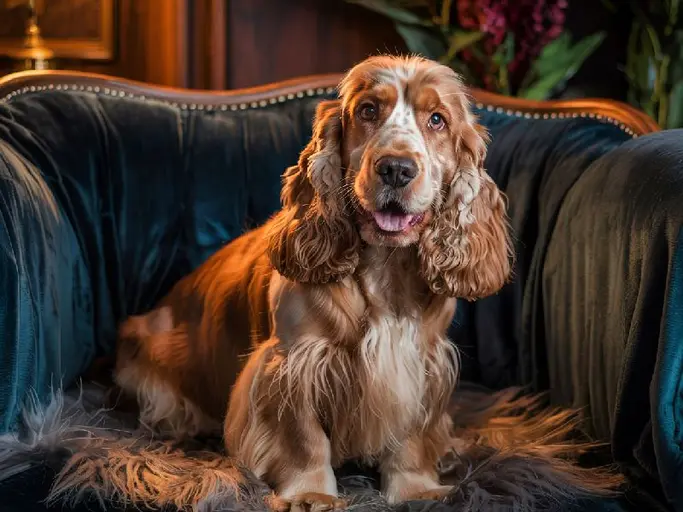Everything You Need to Know About the English Cocker Spaniel

Brief Introduction
The English Cocker Spaniel is a beloved breed known for its cheerful disposition, intelligence, and beautiful, flowing coat. Often described as “merry,” these dogs are prized for their affectionate nature and enthusiasm for life. They make wonderful family pets, thriving on companionship and playful activities. Their history as skilled hunting dogs also makes them intelligent and trainable, although their sensitive nature requires positive reinforcement methods. Their manageable size and adaptable personality make them suitable for various living situations, as long as their exercise needs are met.
Breed History
Origins and Development
The English Cocker Spaniel’s history traces back to Spain, as their ancestors were brought to Britain centuries ago. Originally, all land spaniels were categorized together, with size being the primary differentiator. Those smaller spaniels, skilled at flushing woodcock (a type of bird), were known as “cockers.”
Evolution into a Distinct Breed
Over time, distinct breeding practices led to the separation of the English Cocker Spaniel and the English Springer Spaniel. The English Cocker focused on smaller game and dense undergrowth, while the Springer excelled at larger game and more open terrain. The English Cocker Spaniel Club was officially founded in England in 1902, solidifying the breed’s separate identity. American breeders then diverged again, further refining the Cocker Spaniel type resulting in the American Cocker Spaniel, a smaller more heavily coated dog. The English Cocker remains a bit larger and more athletic than its American cousin. They are capable gundogs and loving family additions.
Role in the Past
The English Cocker Spaniel was primarily bred to be a flushing dog. Their job was to accompany hunters, locate birds in dense cover, and “flush” them out, allowing the hunter to take a shot. They also possess a natural retrieving instinct, making them valuable partners in the field. Their intelligence and willingness to please made them relatively easy to train for these tasks.
Appearance
Size and Build
English Cocker Spaniels are medium-sized dogs. Typically they stand between 15 to 17 inches (38 to 43 cm) tall at the shoulder (withers). Males tend to be slightly larger than females.
Weight
The average weight of an English Cocker Spaniel ranges from 26 to 34 pounds (12 to 15 kg). Their weight should be proportionate to their height and build.
Coat and Color
The English Cocker Spaniel boasts a beautiful, medium-length coat that is silky and flat or slightly wavy. Feathering is present on the ears, chest, legs, and belly. The coat comes in a variety of colors and patterns, including:
- Solid colors (black, liver, red, golden)
- Parti-color (combinations of white with other colors, such as black and white, liver and white)
- Roan (a mixture of white hairs with other colored hairs)
- Tricolor (black, white, and tan or liver, white, and tan)
Head and Facial Features
They have a well-developed head with a distinct stop (the indentation between the eyes). Their muzzle is moderately long and square. Their expression is gentle, intelligent, and alert.
Ears
A defining feature of the English Cocker is their long, pendulous ears, covered in silky feathering. These ears require regular cleaning and care to prevent infections.
Eyes
The eyes are round and dark brown or hazel in color, conveying a soft and appealing expression.
Tail
Traditionally, the tail was often docked, but this practice is becoming less common due to ethical concerns and regulations. Whether docked or undocked, the tail is typically carried level with the back and in constant motion when the dog is happy and alert.
Character and Behavior
Temperament and Personality
English Cocker Spaniels are known for their friendly and affectionate nature. They are generally eager to please and thrive on human interaction. They are intelligent and sensitive dogs and respond best to positive reinforcement training methods.
Attitude Towards People
They are typically very good with people of all ages, including strangers, provided they are properly socialized as puppies. They enjoy being part of the family and dislike being left alone for extended periods.
Interaction with Children
They are generally very good with children, especially when raised with them from puppyhood. However, as with any dog, it’s crucial to supervise interactions between dogs and young children to prevent any accidental injuries or misunderstandings. Teach children how to interact respectfully with the dog and never leave them unsupervised.
Relationship with Other Animals
With proper socialization, English Cocker Spaniels can generally get along well with other dogs and even cats. Early exposure to different animals is essential to ensure they develop positive relationships. Their hunting instincts may kick in with smaller animals like birds or rodents, so caution is advised.
Activity Level
They are moderately active dogs that require regular exercise to stay happy and healthy. Daily walks, playtime in the yard, or a good game of fetch are all good ways to keep them physically and mentally stimulated.
Trainability
English Cocker Spaniels are intelligent and eager to please, making them relatively easy to train. However, they are also sensitive dogs, so positive reinforcement methods are crucial. Harsh training techniques can be detrimental to their well-being and can lead to fear and anxiety. Consistent training sessions, treats, and praise are key to success.
Breed Characteristics
One notable characteristic is their desire to please. They are happiest when they have a job to do, whether it’s retrieving a toy, learning a new trick, or simply being by their owner’s side. They can also be prone to separation anxiety if left alone for extended periods.

Care and Maintenance
Grooming Needs
The English Cocker Spaniel’s coat requires regular grooming to prevent mats and tangles.
- Brushing several times a week is essential to keep the coat looking its best.
- Regular bathing is also necessary, typically every few weeks, depending on the dog’s activity level and environment.
- Professional grooming may be required every few months to trim the coat and keep it in good condition.
- Ears should be cleaned regularly to prevent infections.
- Nails should be trimmed as needed to prevent overgrowth.
Exercise Requirements
They need regular exercise to stay happy and healthy. Daily walks, runs, and playtime are essential. They also enjoy activities that challenge their minds, such as puzzle toys and training sessions. Aim for at least 30-60 minutes of exercise per day.
Diet and Feeding
A high-quality dog food that is appropriate for their age, size, and activity level is essential. Follow the feeding guidelines provided by the food manufacturer and adjust the portion sizes as needed to maintain a healthy weight. Avoid overfeeding, as obesity can lead to various health problems.
Health Considerations
While generally healthy, English Cocker Spaniels are prone to certain health problems.
- **Hip Dysplasia:** A malformation of the hip joint that can lead to arthritis.
- **Progressive Retinal Atrophy (PRA):** A degenerative eye disease that can lead to blindness.
- **Familial Nephropathy:** A kidney disease.
- **Ear Infections:** Their long, floppy ears make them prone to ear infections. Regular cleaning and drying of the ears can help prevent this.
- **Hypothyroidism:** A condition where the thyroid gland doesn’t produce enough thyroid hormone.
- **Autoimmune Hemolytic Anemia (AIHA):** Is a life-threatening disease in which the dog’s immune system attacks its own red blood cells, leading to severe anemia.
Regular veterinary checkups and screening tests can help detect these problems early and allow for prompt treatment.
Lifespan
The average lifespan of an English Cocker Spaniel is typically 12 to 14 years.
Breed Weaknesses
Potential for Aggression
While generally friendly, some English Cocker Spaniels can be prone to aggression, especially if they are not properly socialized or trained. This is more common in poorly bred lines.
Loyalty and Attachment
They are extremely loyal and attached to their families and can suffer from separation anxiety if left alone for extended periods.
Specific Weaknesses
Their long ears need special attention to avoid infections. They also require regular grooming to prevent matting of their coat. Their sensitive nature means that they react poorly to harsh training methods. Because they were bred to hunt, they have a strong chase instinct, which can make it difficult to keep them from running off after small animals.
Conclusion
The English Cocker Spaniel is a wonderful breed for anyone looking for an affectionate, intelligent, and active companion. They are best suited for families who can provide them with plenty of attention, exercise, and training. If you are prepared to meet their grooming needs and address potential health concerns, the English Cocker Spaniel can bring years of joy and companionship to your life. They are truly wonderful dogs, thriving on love and making excellent family pets.
Frequently Asked Questions About English Cocker Spaniel
Are English Cocker Spaniels good family pets?
How much exercise do English Cocker Spaniels need?
What are some common health problems in English Cocker Spaniels?
- Hip Dysplasia
- Progressive Retinal Atrophy (PRA)
- Familial Nephropathy
- Ear Infections
- Hypothyroidism
- Autoimmune Hemolytic Anemia (AIHA)
Regular veterinary checkups can help detect these problems early.

